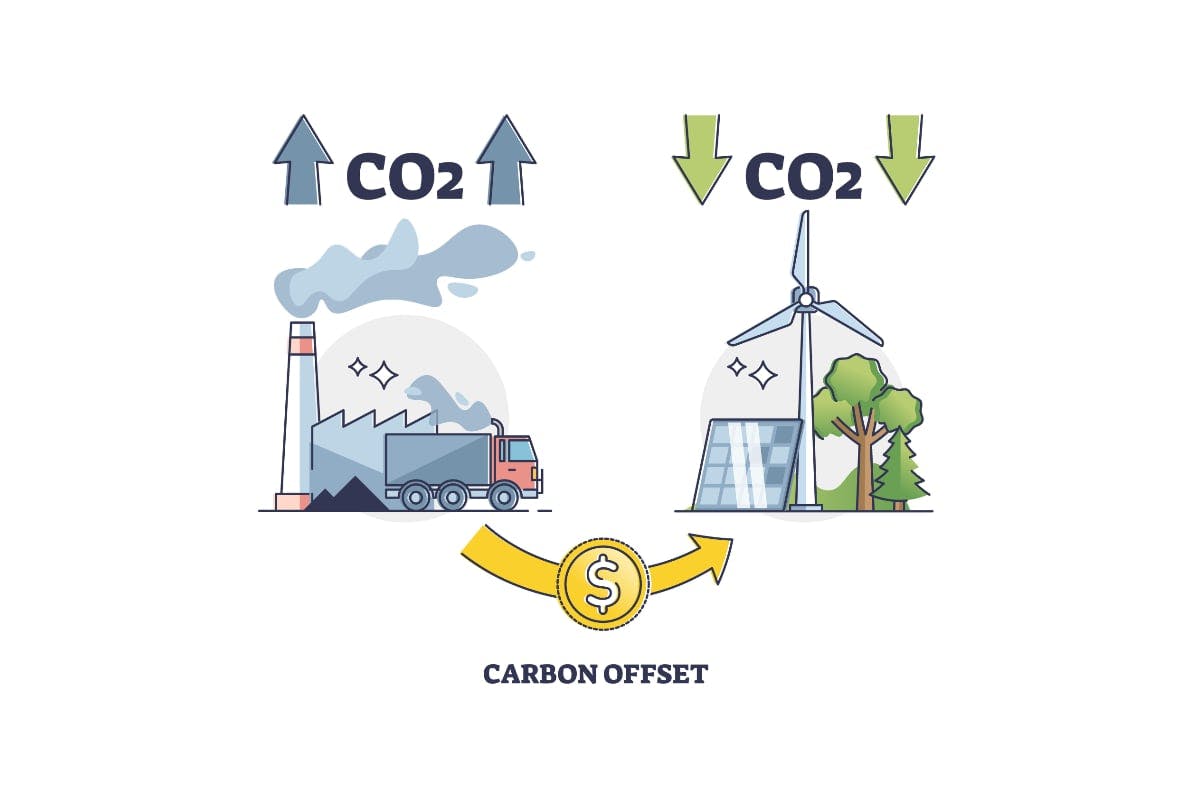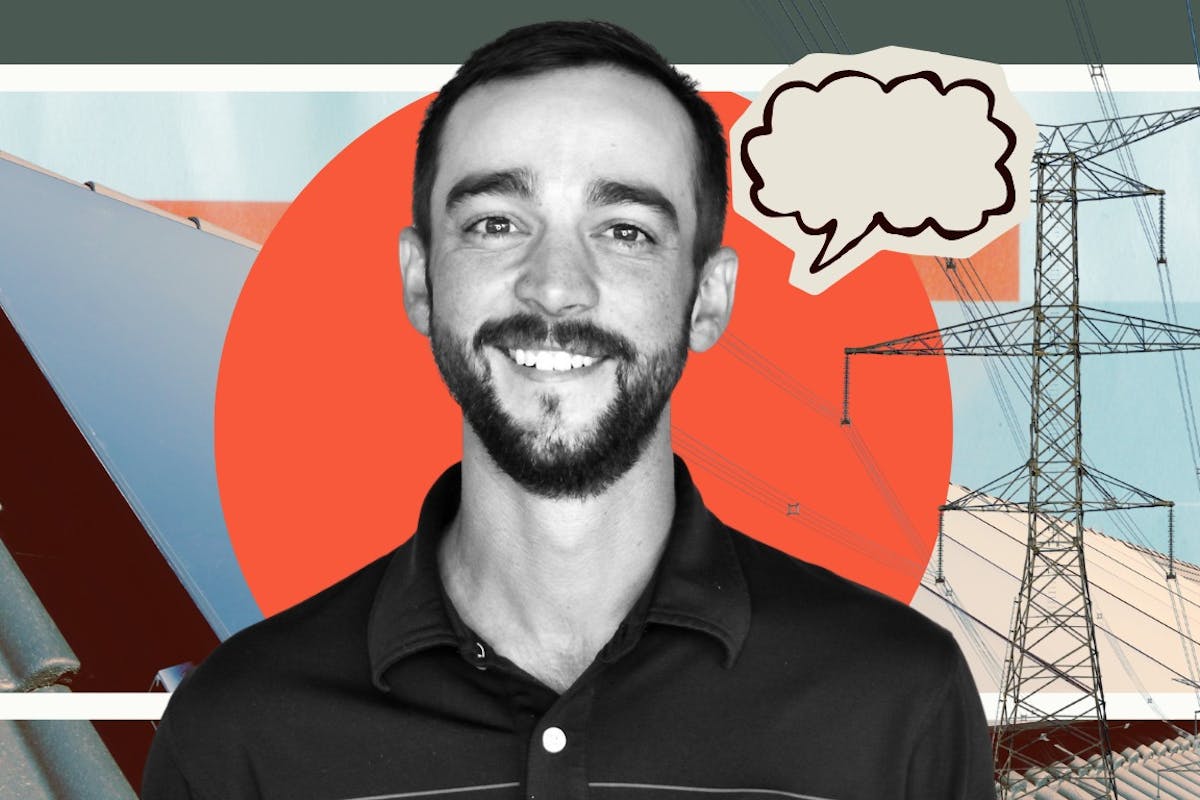What Are Carbon Offsets?
Last edited

Author
Cory O'Brien
Senior Director - Growth Marketing

Editor
Ryan Barnett
SVP, Policy & New Market Development

Human activities such as driving, flying, and using electricity emit greenhouse gases into our atmosphere and contribute to global climate change. Because these activities are part of our daily lives, it can feel like carbon dioxide (CO2) and other greenhouse gas emissions are difficult, if not impossible, to avoid. However, if you can’t totally cease the creation of greenhouse gases, you can still counteract or compensate for some of their production with carbon offsets.
To understand the role of carbon offsets in reducing greenhouse gas emissions, let’s look at what they are, how they work, and key pros and cons.
See how much you can save with home energy changes
Carbon Offset Definition
Carbon offsets are certificates or credits, each of which equates to an emission reduction of CO2 by one metric ton. A business, government, or individual can buy carbon offsets to essentially pay someone else to reduce emissions or remove greenhouse gases, thus compensating for emissions made elsewhere that might not be avoidable.
The goal is to increase carbon reductions and decrease human-caused carbon dioxide (CO2) emissions. According to the Intergovernmental Panel on Climate Change (IPCC), the world needs to cut greenhouse gas emissions in half by 2030 to have a 50% chance of avoiding the worst effects of climate change.
Projects designed to reduce carbon emissions can sell carbon offset certificates to fund their projects. Likewise, individuals, organizations, and local communities looking to offset their CO2 emissions can invest in carbon offset certificates. The goal is to advance projects that counteract the carbon dioxide emissions humans create in daily life, and reduce the temperature rise we’re experiencing.
How Do Carbon Offsets Work?
Carbon offsets allow individuals and organizations a way to mitigate the excess carbon dioxide that human activity adds to the atmosphere. The goal is carbon neutrality or net-zero carbon dioxide emissions, where no net new greenhouse gases are being added to the atmosphere.
For example: If your company produces and ships a variety of goods, the process of making and sending those products likely creates CO2. To offset your impact, you can create or contribute to a project that reduces CO2 emissions. In some cases, you can even make money to fund similar projects in the future.
Our collective carbon emissions, otherwise known as our carbon footprint, are measured by the actions we take. Once you determine how much carbon dioxide you generate over a given period of time, you can take steps to negate your impact.
Carbon offset certificates encourage people and businesses to take specific actions that offset their carbon dioxide production and slow down climate change, helping lower global temperatures.
How are Carbon Offsets Created?
Any person or business wanting to earn carbon offset credits must follow a specific process:
- First, the person or business must design a project and prove it will meet carbon offset criteria.
- The project must be developed, financed, validated by an independent verifier, and registered with a United States carbon offset program. Once registered, it can start generating carbon credits.
- As the project progresses, it must be reviewed regularly to see how many credits it actually creates. This is based on total carbon dioxide reduction, measured in metric tons.
- Once the project is complete, the credits earned must be placed into the person or business's account in an offset programs registry. Credits can then be bought and transferred to another user's account via a carbon market.
Some carbon offset programs that offer registries and approve projects include:
Thankfully, there are several types of carbon offset projects that will generate credits:
- You can capture and destroy greenhouse gases before they are released into the atmosphere. For example, people can capture the methane gas emanating from a landfill.
- You can create carbon sinks in the environment that combat greenhouse gases through natural processes. The best way to do this is by promoting tree planting and the healthy growth and maintenance of new forests. That’s right - go plant some trees!
- You can replace the energy generated from burning fossil fuels with clean, renewable energy resources like home solar and wind.
See how much you can save with home energy changes
How Do You Buy Carbon Offsets?
If you want to buy carbon offset credits, there are a few different ways to get involved:
- You can help finance a project. This typically requires an upfront investment but may net you some of the credits.
- You can work with a project developer to buy credits as they are generated.
- You can search for available offset credits and buy whatever looks appealing to you.
Some popular ways to buy carbon offsets include:
Why Invest in Carbon Offset Credits?
Common reasons you may choose to invest in carbon offset credits include:
- You depend on fossil fuels or coal-powered electricity to create your products and services.
- You and/or your employees frequently travel by air.
- As an individual, you spend a lot of time driving and/or traveling.
- You live in a large home that uses a lot of electricity and other resources like natural gas.
How Do You Sell Carbon Offsets?
If you want to sell carbon offsets, you have to create the offsets first.
- Come up with an idea that will counteract carbon dioxide emissions.
- Register your project with a carbon offset program.
- Complete your project with the required assessment report and check-ins.
- Once the project is complete, place your credits into a personal or business account in the carbon offset registry.
There are two primary ways to sell the credits you create:
- You can find an investor to fund the project in exchange for credits.
undefinedundefined - You can complete the project and let the credits sit in your account in an offset programs registry for anyone to buy.
What Happens After Carbon Offsets are Bought and Sold?
When you buy or sell carbon offsets, you can feel good about helping the environment. However, there can be confusion about what happens to carbon emissions during this process, as it depends greatly on the type of project.
For example, if a project captures methane gas in a landfill and repurposes it for green energy, the offsets literally capture toxic greenhouse gases and stop them from entering the atmosphere.
On the other hand, if the project involves planting trees, it doesn’t immediately eliminate greenhouses gases. Instead, it relies on natural processes to reduce the level of greenhouse gases in our atmosphere over time.
That is the basis of the entire "offsetting" concept. You are completing an action that balances out the greenhouse gases being added to the atmosphere. The environment will still be affected by new and existing greenhouse gases, but the offsets will add positive actions that help minimize the effects.
What are the Pros and Cons of Carbon Offsets?
Carbon offsets are becoming a popular solution to combat climate change, but the process has pros and cons.
The Pros of Carbon Offsets
- They can slow down global warming. Greenhouse gases are a major contributor to global warming and climate change. Projects that help offset the amount of greenhouse gas (GHG) we produce can slow the process of global warming.
- They can save species from going extinct. Global warming is having an extremely negative effect on species across the globe. Their habitats are being changed, and they are not able to adapt quickly enough to survive. Reducing our carbon emissions will help all manner of plant, animal, and insect life survive.
- They encourage people to be more eco-friendly. Since people can sell the carbon offset credits they create, there is a financial benefit to taking care of the planet. This could lead to more people creating more projects that generate carbon credits.
The Cons of Carbon Offsets
- They don’t go far enough. As carbon offsets become more popular, some people may feel they are enough to stop climate change. While carbon offsets can help if used correctly, they are only one step towards fighting climate change.
- They can give people too many excuses. If people can offset the greenhouse gases they produce, they may falsely believe that they can do whatever they want without repercussions.
- They don’t stop future emissions. While carbon offsets do counteract the GHG emissions we create, we must still make an effort to reduce generating new greenhouse gases whenever possible.
You can also lower your carbon footprint without buying or selling carbon offsets:
- Carpool or take public transportation when possible.
- Reduce your energy consumption, fossil fuel use, and single-use plastics.
- Recycle and compost everything possible.
- Only buy what you truly need, and choose items with long-term value, so your purchases don't end up in a landfill producing greenhouse gases.
Carbon Offsets are Good for the Planet
Climate change is affecting our planet, and our global carbon footprint is a big reason for that change. We are generating way too many greenhouse gasses that get trapped in the atmosphere and cause negative effects on the earth.
Carbon offsets are certificates created by completing a project that helps to eliminate greenhouse gases or balance out the gases already in the atmosphere. People can buy and sell these offsets as a way to minimize their contribution to climate change.
However, carbon offsets may be an introductory solution at best. Carbon offset certificates offer one way to balance out the greenhouse gas emissions created by daily human activities, but the real way to slow down climate change is to make more drastic changes to your habits and behaviors. We have to do more than merely offset our existing carbon footprint–we have to lower it significantly.
One of the best ways to personally lower your carbon footprint is by going solar. Learn how you can actively help our planet’s long-term health by installing solar energy panels on your home, and how much you can save, with the Palmetto Estimate Your Solar Savings Tool.


